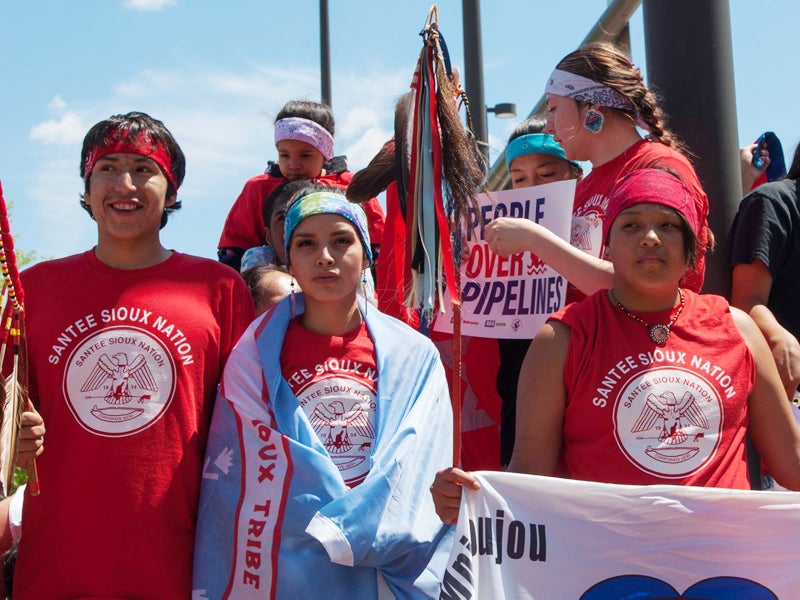Opposing The Dakota Access Pipeline: An Inter-Tribal Spiritual Relay
Native American and non-native youth recently completed an inter-tribal 500-mile relay run to deliver a petition demanding the U.S. Army Corps of Engineers deny permits for the Dakota Access Pipeline Project.

This page was published 9 years ago. Find the latest on Earthjustice’s work.
The U.S. Army Corps of Engineers is currently considering permits for the construction of the Dakota Access Pipeline, a 3.7 billion dollar Bakken oil project that would extend over 1,000 miles across North Dakota, South Dakota, Iowa and Illinois, transferring more than half a million barrels of crude oil per day. The Standing Rock Sioux Tribe, which is fighting to stop this pipeline, is one of many tribes that weren’t consulted properly under the National Historic Preservation Act and other laws before this project was submitted. The project route is proposed to run underneath the Missouri River, just upstream of the Standing Rock reservation and the site where the tribe gets its drinking water. Along the way, it would cross sacred, historic, and culturally significant sites
In response to the pipeline proposal, Native American and non-native citizens initiated a grassroots, inter-tribal 500-mile relay run to personally deliver a petition demanding that the Army Corps deny permits for the oil pipeline project. Earthjustice lawyers are working with the Tribe on legal representation regarding the pipeline and permits. Recently, Earthjustice had the honor of speaking with Waniya Locke of People Over Pipelines, the logistical coordinator of the 500-mile relay.
Earthjustice: Why are tribal citizens so concerned about this pipeline?
Waniya Locke: The main issue is water. The Missouri River provides water for millions of people. The pipeline would cross the Missouri River twice, with potential spills presenting a hazard to the environment. It’s putting us all in danger for them to propose to cross this pipeline across the Missouri river.
This project also violates Section 106 [of the National Historic Preservation Act] because the proposed pipeline route crosses two sacred burial sites that belong to the Standing Rock tribe. There are environmental concerns as well because the project violates EPA laws by failing to provide an Environmental Impact Statement that takes into consideration tribal interests.
EJ: Were any Native American tribes consulted when the Dakota Access Company began planning this pipeline?
WL: None whatsoever, it’s not just Standing Rock that wasn’t consulted; none of the Sioux tribes were consulted. For example, the Oglala Sioux tribe, they get the majority of their water intake from the Missouri river and they were not consulted. The lack of tribal consultation is a violation of the relationship that tribes have with the federal government.
EJ: How have other communities been impacted by pipelines?
WL: Look at the Keystone spill in South Dakota as an example that happened a little less than a month ago. That ground is now contaminated with more than 16,000 gallons of oil and they don’t know how long it will be before that ground will be rejuvenated. These farmers can no longer plant, and the question is, “When can they plant?”
EJ: What else will be affected if this project gets approved?
WL: It’s not only going to affect humans, it’s going to affect ecosystems, it’s going to affect animals, it’s going to affect the environment and it’s a long-term impact. We’re jeopardizing land animals and birds as well.
EJ: Why did you decide to do a 500-mile relay? Why not just deliver the petition?
WL: We could have just driven up—that would have been the easiest—but we wanted to impact the people, we wanted to show that unity and prayer are what brings people together and makes huge movements. It was amazing to see the runners go to the different communities and to have them educate people on the Dakota Access Pipeline.
Every time runners stopped they gave a presentation explaining the pipeline and how it’s going to affect them in their communities. This movement was done through prayers; it was educational, but it was healing. We did it this way to bring unity and awareness to our communities, and most of all it was healing for our youth. This was an inter-tribal effort. It was an unselfish act and the communities deserve the credit.
EJ: What was your role in this inter-tribal grassroots initiative?
WL: My job was to make sure that all the regional coordinators were effectively communicating. It was incredible; we had 14 coordinators who were such an amazing team. It was all the tribes and communities who made this possible. This was a community effort; everyone stepped up and got involved.